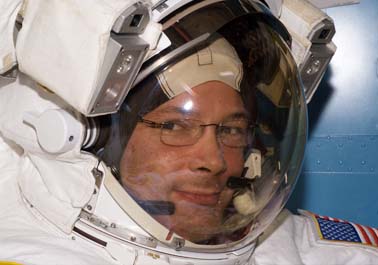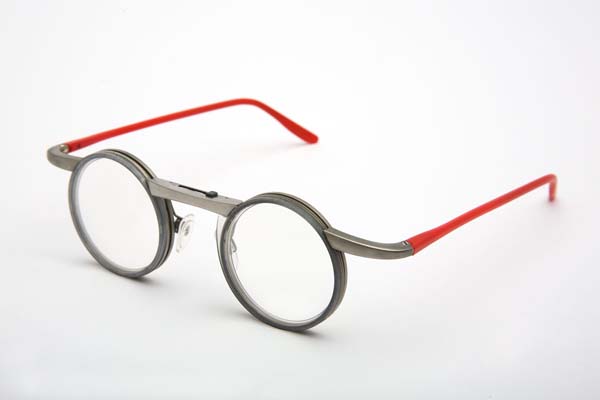Space Specs
Eyeglasses for the aging astronaut
It's no secret that the astronaut corps today, with an average age between 47 and 48, is a bit older than the in-their-primers of Mercury and Gemini. And eyesight, it turns out, is one measure of age. Approximately 80 percent of the current astronaut corps wears eye correction (i.e. glasses or contact lenses). So on any given shuttle flight, a few crew members typically take along eye correction for presbyopia, the far-sightedness that comes from the aging and hardening of the optic lens, making it difficult to read manuals, instruments, or anything else at close range (picture your dad holding a letter at arm's length and frowning). As long as the astronauts' vision is correctable to 20/20, they're allowed to fly. Even Apollo veteran John Young took his reading glasses along on STS-1.

On STS-133, two of the crew who use glasses will try out a new type of spectacles called Superfocus lenses, that offer improved vision for working in tight quarters. And they'll take along two more pairs for people on the International Space Station. NASA isn't saying who needs them and who doesn't.
"The bottom line is that with a bifocal there are limitations," says Dr. C. Robert Gibson, NASA's in-house optometrist for the astronauts. "They're okay for reading and looking at a distance, but they don't allow you to look overhead without having to throw your head way back, looking through the reading portion. When you're in a spacecraft environment, you're having to look overhead at panels, different viewing angles, different focal lengths. And if you're presbyopic, that can be quite challenging."

The new glasses, developed by Superfocus, LLC, of Van Nuys, California, have a hard front lens that might or might not have the prescription you need for distance viewing; then a second, flexible lens behind it. Between the two lies a filtered silicone oil analogous to the fluid injected into the eyeball during retinal surgery to prevent the eye from collapsing. By pushing a tiny slider button across the top of the bridge between the lenses, you can adjust the bulge of the flexible lens and change the focal length.

Gibson stumbled across the glasses reading a professional journal last year. "I thought, Wow, these sound pretty interesting. These would be ideal for spaceflight. The optics of that silicone are just incredible. Better than any optics I've ever seen in a pair of glasses, personally. And I wear glasses. There's just no distortion. All bifocals and progressive lenses have a certain amount of inherent distortion. If you're looking for something to give you your best, widest field of view, without having to look in all directions, whether you're looking overhead, to the side, whatever, they're pretty awesome." NASA's not officially endorsing them in any way, he says. They've simply approved a trial on shuttle and station.
A drawback is that they're heavier than other glasses—oh, never mind, it's a non-issue in zero gravity.
If you'd care to order a pair directly from the company's web site, you'll experience a little gravity in the price tag: around $700. But hey, for perfect, adjustable vision on the fly, who's counting?

On STS-133, two of the crew who use glasses will try out a new type of spectacles called Superfocus lenses, that offer improved vision for working in tight quarters. And they'll take along two more pairs for people on the International Space Station. NASA isn't saying who needs them and who doesn't.
"The bottom line is that with a bifocal there are limitations," says Dr. C. Robert Gibson, NASA's in-house optometrist for the astronauts. "They're okay for reading and looking at a distance, but they don't allow you to look overhead without having to throw your head way back, looking through the reading portion. When you're in a spacecraft environment, you're having to look overhead at panels, different viewing angles, different focal lengths. And if you're presbyopic, that can be quite challenging."

The new glasses, developed by Superfocus, LLC, of Van Nuys, California, have a hard front lens that might or might not have the prescription you need for distance viewing; then a second, flexible lens behind it. Between the two lies a filtered silicone oil analogous to the fluid injected into the eyeball during retinal surgery to prevent the eye from collapsing. By pushing a tiny slider button across the top of the bridge between the lenses, you can adjust the bulge of the flexible lens and change the focal length.

Gibson stumbled across the glasses reading a professional journal last year. "I thought, Wow, these sound pretty interesting. These would be ideal for spaceflight. The optics of that silicone are just incredible. Better than any optics I've ever seen in a pair of glasses, personally. And I wear glasses. There's just no distortion. All bifocals and progressive lenses have a certain amount of inherent distortion. If you're looking for something to give you your best, widest field of view, without having to look in all directions, whether you're looking overhead, to the side, whatever, they're pretty awesome." NASA's not officially endorsing them in any way, he says. They've simply approved a trial on shuttle and station.
A drawback is that they're heavier than other glasses—oh, never mind, it's a non-issue in zero gravity.
If you'd care to order a pair directly from the company's web site, you'll experience a little gravity in the price tag: around $700. But hey, for perfect, adjustable vision on the fly, who's counting?